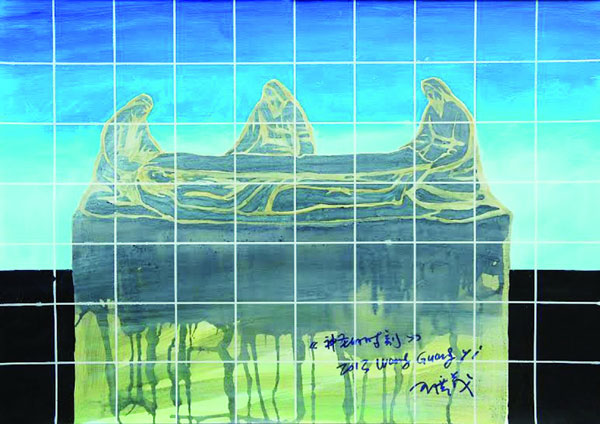 |
|
The works in his latest exhibition reveal his interest in the enigma of the Shroud of Turin, a centuries-old linen cloth that bears the image of a crucified man that millions believe to be Jesus of Nazareth.Photo Provided to China Daily
|
In Viaggio in Italia, for the first time in Wang's 30-year career, we find self-portraits, a genre that he has hardly experimented with. "I remember drawing a self-portrait more than 10 years ago, as if by chance. Most of my self-portraits have been drawn during chance standstills in the creative process. I understand drawing a self-portrait as a brief exercise in self-examination does not have a universal significance."
Undoubtedly, Wang produces work that is associated with transcendence, the "metaphysical", something that goes "beyond physics". But at the same time it is well-rooted in the mundane world. We can probably talk in terms of a dualistic vision, and whatever dualism pervades his thought is one of spontaneity.
"Critics use the words 'transcendent' and 'metaphysical' when interpreting my art, and even I use them at times when talking about my work, but in reality I am uncertain if there is anything transcendental or metaphysical in my art," Wang says.
"An artist often falls into the material world to understand the forms which can be perceived and experienced, while creating something. As for me, when I am dealing with these materials, I can't help but encounter Plato's 'Theory of Ideas'."
The philosopher thought that only the world of ideas is real, while perception, concrete concepts and experience are nearly illusory, Wang says of Plato. "According to Plato, that creative experience leads me out of falling, but keeps me in a space of illusion, in an illusionary state."
In his latest exhibition, it becomes clear that the atheist Wang is intrigued by the enigma of the Shroud of Turin. There is a series dedicated to it.
"My interest in the shroud lies in the fact that I see it as a myth which is associated with Christianity. Its authenticity has been the subject of much controversy, and this sort of controversy in itself is enormously attractive to me from an artistic point of view. Of course, it is also connected to my early experience of studying the history of Western art."
Recently, Wang also created a series inspired by the apostles. In his mind, they symbolize workers deprived of their rights, the poor and the neglected. Does he believe art can save or fix the world?
"It was relevant. In the early period of my life as an artist, I believed at one point that art could indeed rescue and restore this world. But now I think that art can rescue and repair, but possibly only the artist himself or herself."
Wang is now working on his next exhibition, a retrospective at the Gas Natural Fenosa Museum of Contemporary Art in Coruna, Spain, where it will be staged in July.
